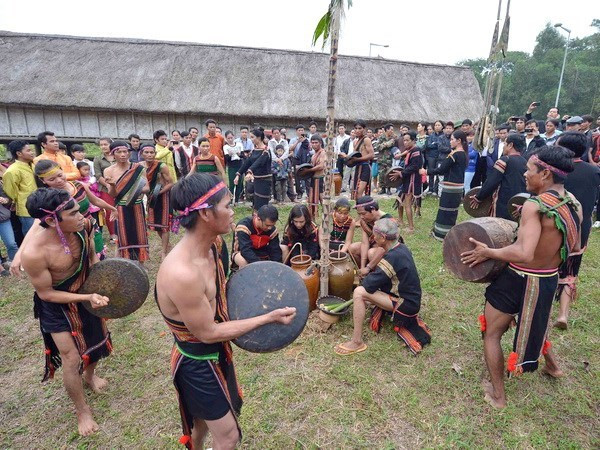 Dancing performance by Ede ethnic group at Vietnam National Village for Ethnic Culture and Tourism. (Photo: VNA)
Dancing performance by Ede ethnic group at Vietnam National Village for Ethnic Culture and Tourism. (Photo: VNA)Traditional musical instruments and skills of ethnic groups in central Binh Dinh province are likely to gradually disappear without preservation efforts, particularly those within each community.
Binh Dinh’s ethnic population amounts to about 40,000 people, mostly belonging to Ba Na Kriem, Cham Hroi and Hre groups.
According to 78-year-old Le Van Ru, a notable Cham Hroi musician in Hiep Hoi village, Van Canh district, his descendants now do not know how to sing or dance any piece of folk music.
Willingly taught by village elders, folk singing and gong dancing are not difficult to learn but do require regular practice which the youth cannot afford as their time is often occupied by studying and working, shared Ru.
Modern pressure often confuses young people between traditional culture and civilisation. With a fear of being seen as old-fashioned, more and more of them are refusing their native culture.
With the youth unable to speak the local vernacular or choosing not to wear loincloths and traditional rites cut short to save time, beauties of the old days will fade away, said Nguyen Hieu, coordinator of a Bana gong club in To Lok village in Vinh Thanh district.
Hieu is also among devotees who are striving to preserve long-standing customs passed down from their ancestors. The elderly man set up his club in 2003 and has knocked on doors to mobilise villager engagement. Currently, Hieu and his fifty members gather every month and organise concerts at home and in other provinces.
Hoang Ngoc Thanh, Head of An Lao district’s information and communications office, acknowledged cultural education as a key solution to the issue.
The more people understand the values, the more they want to learn and maintain them, Thanh noted, saying his agency has long facilitated the establishment of traditional music clubs.
Recently, An Lao hosted a biennial cultural festival, gathering nearly 600 ethnic residents.-VNA



























